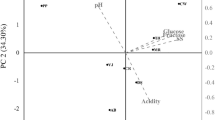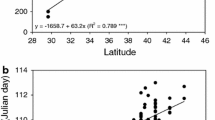Abstract
This study was conducted to compare fruit quality traits and phytochemical compounds of new Turkish persimmon (Diospyros kaki L.) cultivars with commercial persimmon cultivars commonly grown around the world. Cultivars included in both pollination-constant non-astringent (PCNA) and pollination-variant non-astringent (PVNA) groups were selected. Significant differences were detected in fruit quality traits and phytochemical compounds of the cultivars. The ‘Fujiwaragosho’ cultivar of the PCNA group had a lower number of seeds and higher phytochemical compound content than the other cultivars of the same group. Turkish cultivars, all included in the PVNA group, had higher values for quality traits and phytochemical compounds. The ‘Ayder’ cultivar of the PVNA group was ranked first terms of vitamin C, while the ‘Akbulut’ cultivar ranked first in terms of total phenolics and antioxidant activity. Principal component analysis (PCA) revealed that local cultivars had values for quality traits close to commercial cultivars of the world markets. The ‘Akbulut’, ‘Ayder’ and ‘Fujiwaragosho’ cultivars, placed on the first principle component axis and exhibiting 29.19% variation, had the highest values for phytochemical compounds. In ‘Akbulut’, ‘Ayder’ and ‘Fujiwaragosho’ cultivars, vitamin C levels were identified as 15.50, 19.00, and 18.90 mg per 100 g; total phenolics as 32.88, 14.95, and 27.62 g GAE kg−1 fresh weight (fw); and antioxidant activity (DPPH and FRAP) as 1.01–25.55, 0.92–6.42, and 0.97–22.76 mmol TE kg−1 fw, respectively. It was concluded that in terms of quality traits and phytochemical compounds, new Turkish persimmon cultivars are able to compete with commonly grown commercial cultivars.

Similar content being viewed by others
References
Benzie IF, Strain JJ (1996) The ferric reducing ability of plasma (FRAP) as a measure of “antioxidant power”: the FRAP assay. Anal Biochem 239(1):70–76
Brown JS (1991) Principal component and cluster analysis of cotton cultivar variability a cross the U.S. cotton belt. Crop Sci 31:915–922
Butt M, Sultan MT, Aziz M, Naz A, Ahmed W, Kumar N, Imran M (2015) Persimmon (Diospyros kaki L.) fruit: hidden phytochemicals and health claims. EXCLI J 14:542–561
Çelik A, Ercişli S (2008) Persimmon cv. Hachiya (Diospyros kaki Thunb.) fruit: some physical, chemical and nutritional properties. Int J Food Sci Nutr 59:599–606
Chang C, Yang M, Wen H, Chern J (2002) Estimation of total flavonoid content in propolis by two complementary colorimetric methods. J Food Drug Anal 10:178–182
Del Bubba M, Giordani E, Pippucci L (2009) Changes in tannins, ascorbic acid and sugar content in astringent persimmons during on-tree growth and ripening and in response to different postharvest treatments. J Food Compos Analysis 22(7–8):668–677
El Had MAM, Bu Q, Ge B, Cao C, Zhou C (2017) Analysıs of maın qualıty characterıstıcs of persımmon (Diospyros kaki L.) fruıts. Int J Adv Res 5(12):970–986
Ercişli S, Akbulut M, Ozdemir O, Sengul M, Orhan E (2008) Phenolic and antioxidant diversity among persimmon (Diospyrus kaki L.) genotypes in Turkey. Int J Food Sci Nutr 59(6):477–482
Heras RML, Pinazo A, Heredia A, Andrés A (2017) Evaluation studies of persimmon plant (Diospyros kaki) for physiological benefits and bioaccessibility of antioxidants by in vitro simulated gastrointestinal digestion. Food Chem 214:478–485
Jang IC, Oh WG, Ahn GH, Lee JH, Lee SC (2011) Antioxidant activity of 4 cultivars of persimmon fruit. Food Sci Biotechnol 20(1):71–77
Jung ST, Park YS, Zachwieja Z, Folta M, Barton H, Piotrowicz J, Katrich E, Trakhtenberg S, Gorinsten S (2005) Some essential phytochemicals and the antioxidant potential in fresh and dried persimmon. Int J Food Sci Nutr 56(2):105–113
Karataş F, Mukhtar ZG, Ibrahim MS, Ibrahim Yİ (2019) Amounts of vitamin A, vitamin E, vitamin C, β‑carotene, lycopene, ghrelin, glutathione, and MDA in fruits of Diospyros kaki L. Gıda 44(4):585–592
Kayacan S, Karasu S, Akman PK, Goktas H, Doymaz I (2020) Effect of different drying methods on total bioactive compounds, phenolic profile, in vitro bioaccessibility of phenolic and HMF formation of persimmon. LWT Food Sci Technol 118:108830
Lee JH, Lee YB, Seo WD, Kang ST, Lim JW, Cho KM (2012) Comparative studies of antioxidant activities and nutritional constituents of persimmon juice (Diospyros kaki L. cv. Gapjubaekmok). Prev Nutr Food Sci 17(2):141
Martínez-Calvo J, Naval M, Zuriaga E, Llácer G, Badenes ML (2013) Morphological characterization of the IVIA persimmon (Diospyros kaki Thunb.) germplasm collection by multivariate analysis. Genet Resour Crop Evol 60:233–241. https://doi.org/10.1007/s10722-0129828-4
McGuire RG (1992) Reporting of objective color measurements. HortScience 27(12):1254–1255
Mohammadi SA, Prasanna BM (2003) Analysis of genetic diversity in crop plants—Salient statistical tools and considerations. Crop Sci 43:1235–1248
Murathan ZT (2020) Phytochemical screening and antioxidant activity of Diospyros lotus L. fruits grown in Turkey. Acta Sci Pol Hortorum Cultus 19(2):49–55.
Nazir A, Wani SM, Gani A, Masoodi FA, Haq E, Mir SA, Riyaz U (2013) Nutritional, antioxidant and antiproliferative properties of persimmon (Diospyros kaki)—a minor fruit of J&K India. Int J Adv Res 1(7):545–554
Novillo P, Besada C, Tian L, Bermejo A, Salvador A (2015) Nutritional composition of ten persimmon cultivars in the “ready-to-eat crisp” stage. Effect of deastringency treatment. Food Nutr Sci 6(14):1296–1296
Onur C (1990) Trabzon Hurması. Derim 7(1):4–47
Özdamar K (2004) Paket Programlar ile Đstatiksel Veri Analizi (Çok Değişkenli Analizler). 5. Baskı Kaan Kitapevi. (528s)
Ozturk B, Celik S, Karakaya M, Karakaya O, Islam A, Yarılgac T (2017) Storage temperature affects phenolic content, antioxidant activity and fruit quality parameters of cherry laurel (Prunus laurocerasus L.). J Food Process Preserv 41(1):e12774
Ozturk B, Uzun S, Karakaya O (2019) Combined effects of aminoethoxyvinylglycine and MAP on the fruit quality of kiwifruit during cold storage and shelf life. Sci Hortic 251:209–214
Parseker Yönel S, Uylaser V, Yonak S (2008) Trabzon hurmasının bileşimi ve besleyici değeri. Türkiye 10:21–23
Satmaz A (2013) Bazı Yerli Ve Yabancı Trabzon Hurması Çeşit Ve Tiplerinin Morfolojik Karakterizasyonu Çukurova Üniversitesi Fen Bilimleri Enstitüsü Bahçe Bitkileri Anabilim Dalı Yüksek Lisans Tezi.
Shahkoomahally S, Ramezanian A (2013) Analytical and statistical ınterpretation of relationship between total antioxidant activity, ascorbic acid content, total phenolic compounds, soluble tannin and chromatic parameters of persimmon (Diospyros kaki) cv. ’Shiraz’ during cold storage. Agrıc Commun 1(1):17–22
Singleton VL, Rossi JA (1965) Colorimetry of total phenolics with phosphomolybdicphosphotungstic acid reagents. Am J Enol Vitic 16(3):144–158
UPOV (2004) Working paper on test wide lines for Diospyros kaki L.f. TG/92/4. UPOV, Geneva
Yadav A, Fennec A, Guan C, Yang Y, Kochanek B, Israel D, Friedman H (2021) Phenotypic characterization of postharvest fruit qualities in astringent and non-astringent persimmon (Diospyros kaki) cultivars. Front Genet 12:909
Yeşiloğlu T, Kacar YA, Yılmaz B, İncesu M, Çimen B (2017) Bazı yerli ve yabancı Trabzon Hurması (Diospyros kaki L.) çeşit ve tiplerinin morfolojik ve moleküler karakterizasyonu. Turkish J Agric Food Sci Technol 5(12):1580–1589
Yonemori K, Kanzaki S, Honsho C, Akagi T, Parfitt D (2008) Phylogeny and cultivar development of Diospyros kaki: a survey based on molecular analyses. Adv Hortic Sci 22(4):261–268
Yıldız E (2005) Hatay ili Trabzon Hurmalarının Seleksiyon Yoluyla Islahı. MKÜ Fen Bilimleri Enstitüsü Bahçe Bitkileri Anabilim Dalı Yüksek Lisans Tezi, Antakya
Yıldız E, Kaplankıran M, Toplu C (2004) Preliminary findings in Hatay province persimmon selection. I Persimmon Cultivation and Marketing Symposium, Ünye, pp 103–110
Yılmaz B, Genç A, Çimen B, İncesu M, Yeşiloğlu T (2017) Characterization of morphological traits of local and global persimmon varieties and genotypes collected from Turkey. Turk J Agric For 41(2):93–102
Funding
The author is grateful for the support of the General Directorate of Agricultural Research and Policies (TAGEM) Scientific Research Council (project no.: TAGEM/TBAD/13/A01/P01/002).
Author information
Authors and Affiliations
Contributions
N. Aksu Uslu: methodology, investigation, conceptualization, validation, writing—original draft, visualization.
Corresponding author
Ethics declarations
Conflict of interest
N. Aksu Uslu declares that she has no competing interests.
Rights and permissions
Springer Nature oder sein Lizenzgeber hält die ausschließlichen Nutzungsrechte an diesem Artikel kraft eines Verlagsvertrags mit dem/den Autor*in(nen) oder anderen Rechteinhaber*in(nen); die Selbstarchivierung der akzeptierten Manuskriptversion dieses Artikels durch Autor*in(nen) unterliegt ausschließlich den Bedingungen dieses Verlagsvertrags und dem geltenden Recht.
About this article
Cite this article
Aksu Uslu, N. Evaluation of Quality Traits and Phytochemical Compounds of Persimmon (Diospyros kaki L.) Cultivars Grown in Samsun, Turkey. Erwerbs-Obstbau 65, 889–897 (2023). https://doi.org/10.1007/s10341-022-00753-z
Received:
Accepted:
Published:
Issue Date:
DOI: https://doi.org/10.1007/s10341-022-00753-z




